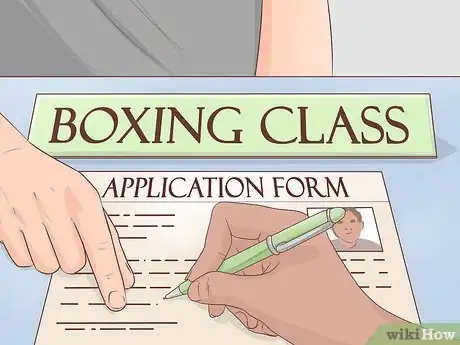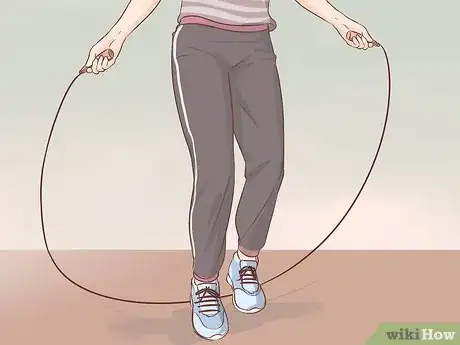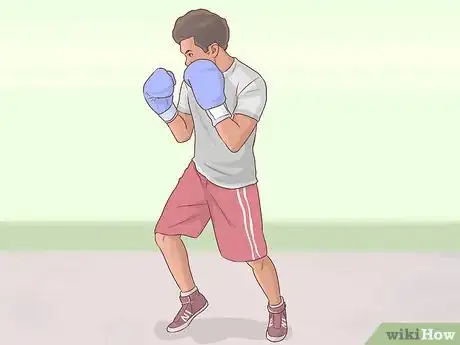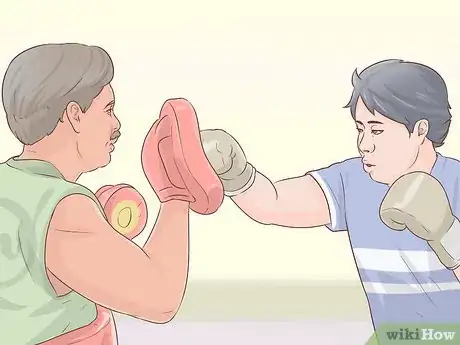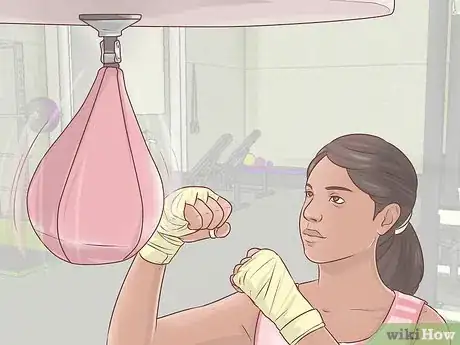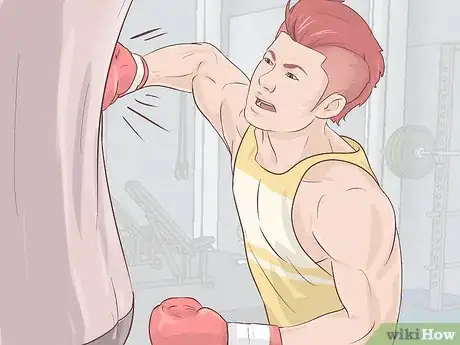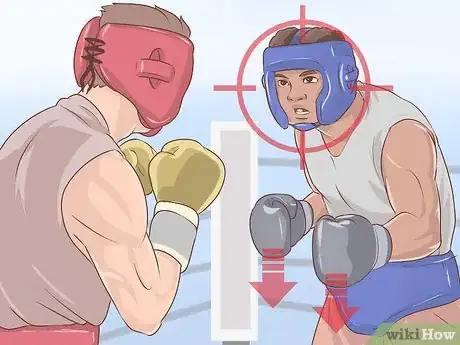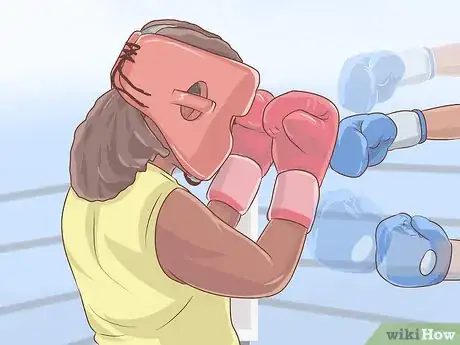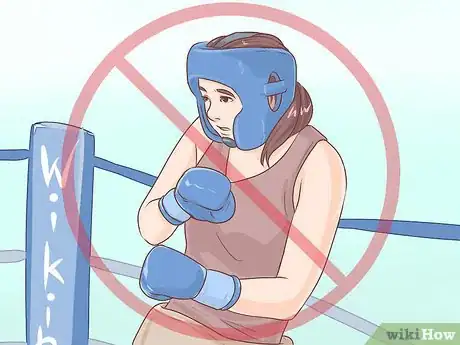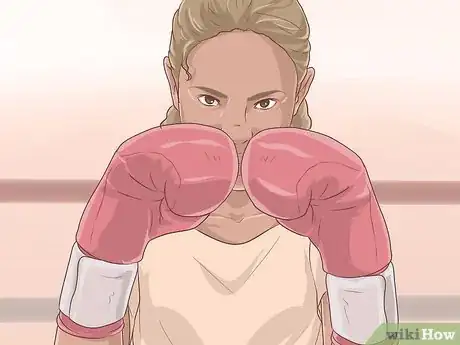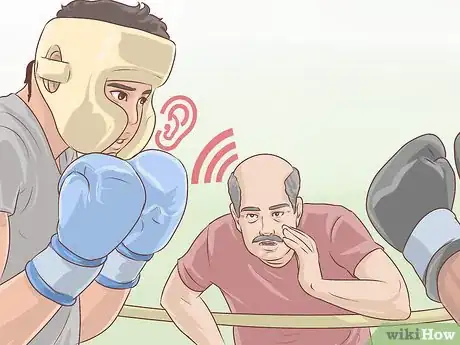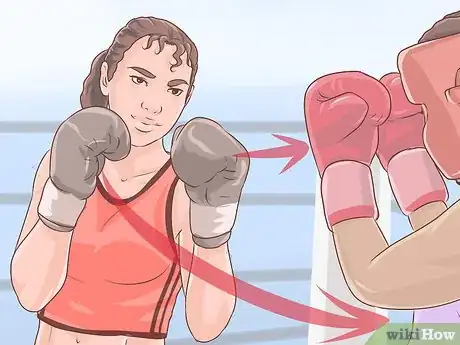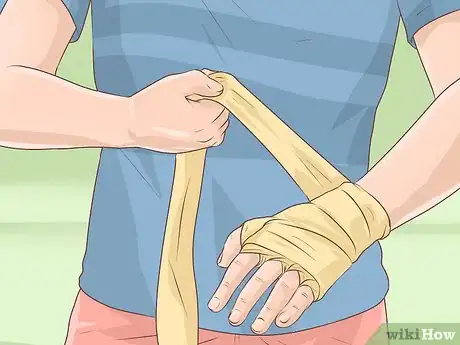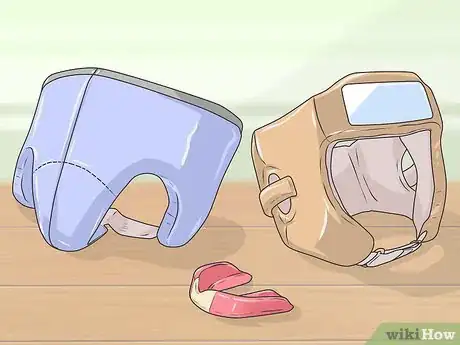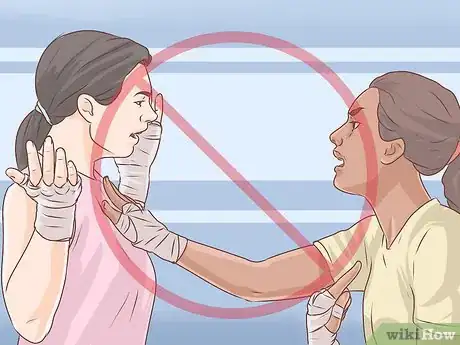This article was co-authored by David Engel. David Engel is a Muay Thai Instructor and Self Defense Trainer based in the San Francisco Bay Area. With over 15 years of martial arts instruction and training experience, David runs California Martial Athletics with co-owner Joe Chernay. He has created and maintained martial arts programs at Rise Combat Sports in San Francisco and Round 5 Martial Arts Academy in San Leandro, with a mission to provide students with a level of comfort and competency that manifests both within and outside the martial arts context. He is also a registered cornerman for amateur and pro competitors under the IKF (International Kickboxing Federation). David was the youngest apprentice instructor of the Thai Boxing Association of America under Ajarn Chai Sirisute (2009), and was a top-ranked amateur competitor in his weight class (127-130 lb) in California between 2013 and 2015.
There are 15 references cited in this article, which can be found at the bottom of the page.
wikiHow marks an article as reader-approved once it receives enough positive feedback. In this case, 89% of readers who voted found the article helpful, earning it our reader-approved status.
This article has been viewed 85,142 times.
The exhilaration of being in a boxing match is unlike any other feeling in the world. The rush of being in a fight, the adoration of fans, and the recognition of other fighters are all things that an aspiring boxer may want. However, being a boxer is also one of the most difficult things that you can ever do. Training requires patience, dedication, intensity, and effort and not all people can stick with it long enough to compete. Luckily, if you train correctly, listen to experienced boxers, and put in the time that it takes to become good, you can become a prizefighter too.
Steps
Training to Be a Boxer
-
1Sign up for classes at a local boxing gym. Look online for boxing gyms in your area and find one near you. Once you find a location that you can travel to regularly, visit them or call them on the phone to see what times they offer classes and how much they cost. Many gyms offer a per-session rate as low as $10-$50, so you can try out the gym before committing to a monthly plan.[1]
- Go to the gym before committing to classes to see how comfortable you feel with the trainers there. The best gyms will have trainers who are understanding and respectful to all skill levels.
- Read reviews online to get a better idea of how past students felt about the training there.
-
2Jump rope, run, and perform other exercises to improve your stamina. One of the most important aspects of being a good boxer is having an efficient cardiovascular system. Boxing is one of the most physically demanding sports and requires a lot of endurance to fight multiple rounds. Conventional boxing exercises include running, jumping rope, hitting the heavy bag, shadow boxing, sparring, or doing circuit exercises and light weight lifting.[2] Before sparring or doing any technique training, you should do a cardio work out for at least 30 minutes to an hour each day.
- When you're running, focus on long-distance running, which will help you improve your stamina, as well as sprints, which simulate the chaos and quick exchanges within a fight.[3]
- Do exercises like uphill sprints, jump squats, cycling, swimming, and jumping rope to improve your balance, stamina, and leg strength.[4]
- If you are out of shape, you may need to concentrate more on your stamina than the average person.Don't let bad cardio stand in the way of your boxing dreams. Joining a gym will help you improve cardio drastically if you stay committed.
Advertisement -
3Learn the proper boxing technique. Technique in boxing is far more valuable than brute strength. Speed plus technique equals power, so bodybuilding or having big muscles with no practical strength will not help you. In boxing, you must learn how to stand correctly and how to throw a variety of punches.
- The standard boxing stance has your back leg slightly bent with your weight on it and your toe at an angle. Your non-dominant foot should be pointed forward. Both hands should cover your chin and face.
- You will need to master all the basic punching techniques which include jabs, straights, uppercuts, and hooks.[5]
-
4Work with a trainer. A trainer can show you how to move forward, back, and side to side while staying guarded, as well as how to block and slip punches. It's important to have good chemistry with the trainer you are working with. Make sure to communicate with them and tell them what your goals are.
- Your trainer should do pad work with you, which will help you gradually condition your body to the demands of boxing.[6]
- If you are a little more experienced with boxing, let your trainer know that you know the basic form and technique, so you don't waste time.
- Always listen to what your trainer has to say. Trainers can see things from a more objective view and will help you improve your skills.
-
5Practice on the speed bag. The speed bag helps a boxer with timing and accuracy. Use one hand and punch the speed bag slowly at first. See how the bag acts when it bounces off the backboard and try to hit it when it is swinging back. Once you manage to control it, increase your pace and start using both of your hands.[7]
- Mastering the speed bag is not easy and will likely require hours of practice before you can get the correct rhythm.
-
6Practice on the heavy bag. The heavy bag helps a fighter work on his technique and power. Remember always to wrap your hands and wear gloves before practicing on the heavy bag. Start by throwing light jabs, straights, and hooks to the heavy bag. Your punches should be quick and crisp. Also remember that a punch's full range of motion includes bringing your hand back to protect your face.
- A common misconception is that the heavy bag should sway back and forth. This indicates "pushing" punches, which don't utilize proper technique.
- Even though a heavy bag can't hit back, it's essential you maintain good form while using it so you don't hurt yourself.
-
7Remain dedicated even when it gets tough. Boxing is one of the most grueling sports to train in and requires dedication and pushing yourself past your limits. In boxing you'll need to build up an incredible amount of stamina, toughness, power, and speed to defeat your opponents in the ring.[8]
- If you are a competing boxer, you should workout five days a week for three to five hours to stay in fighting shape.[9]
- If you feel like giving up, push yourself to keep going. You will not see improvement until you push yourself past what you thought you couldn't accomplish.
- If you want to really take your boxing to the next level, take notes or watch film on all of your fights, and use information about your wins and losses to help you adjust your training.[10]
-
8Spar with classmates when you're ready. Once you have the basics down, and your cardio and stamina are good enough, you should begin sparring with other people that train at your gym. Talk to your trainer to see if you're ready, then choose a sparring partner with a similar skill level. Sparring will show you to how it feels to deliver and receive punches in the ring.
- Don't start sparring too early. Work with your coach to develop good fundamentals, like control and balance, as well as to overcome the instinct to flinch or close your eyes when you're against an opponent.[11]
- Do not try to hurt your sparring partner. The aim is not to win, but improve both of your skills and get practical experience in the ring.[12]
- If you have to spar with a more experienced fighter, they will likely go easy on you. You should do the same if you are sparring someone with less experience.
Fighting In the Ring
-
1Don't exert all your energy in the first couple rounds. Maintaining your endurance during a boxing match can be harder than other sports, because of psychological factors that may make you more nervous and interrupt your breathing.[13] Pace yourself in the fight and don't make unnecessary movements or punches if you know they are not going to help you win.
- The first round should be a feeling out round. Use defense and evaluate your opponent's technique.
-
2Look for holes during the first couple rounds. Find weaknesses in the opponents defense that you can exploit as the match progresses, instead of punching wildly and becoming tired. Take note of the bad habits or tendencies that they have as a fighter. For instance, if they always lower one hand when they throw a straight, this is an opportunity to counter with a hook.
- If they put their hands down when they are disengaging, this is a good opportunity to move in and land some solid face punches.
- If they don't protect their body, land body shots early in the fight, so you tire them out as the match progresses.
-
3Tire your opponent out. If you can defend properly and your opponent punches wildly, you can make them tired and take advantage of his lack of endurance during the later rounds. If your opponent is a power puncher and is looking to land one good shot, make sure to stay mobile and always keep your hands up.
- Explosive punchers become tired more quickly because of the energy that they spend on each strike.[14]
-
4Don't stay on the ropes undefended. Do not stay immobile and defensive on the ropes, or the referee may stop the fight early. Even when you are blocking, it's up the ref to make the final decision on whether the fight should continue. Also, being on the ropes limits your mobility and reduces your options if you need to move back.[15]
-
5Keep your hands up. During the later rounds, you may become tired, and your hands will most likely start to fall, leaving your face and head exposed. This is the perfect opportunity for an opponent to take advantage of a hole in your defense and knock you out. Always keep your hands up unless you are defending body shots.
- A boxer with a lot of power can punch through your block and cause damage even if you have your hands up. In this case, use lateral movement to stay away from his strikes.
- Use a combination of head movement and blocking to defend strikes and tire out your opponent.[16]
-
6Listen to your corner. Your corner will be able to see the fight from a different angle and can tell you where you need to improve and how and why you are winning or losing the fight. Make sure to listen to them between rounds and try to make adjustments as the fight progresses.
- It's easy to develop tunnel vision during a fight and block out any noise or advice, but this will only work against you.
-
7Determine your style. Once you've learned the fundamentals and have spent time competing, you'll most likely have a style of your own. While the basic building blocks must always be there, people are proficient in different things. Leverage whatever your best assets are and use them in your boxing strategy.
- If you are a powerful puncher, work on your blocking technique and opening up your opponent's defense by landing body shots.
- If you have really good stamina, try wearing down your opponent and taking the fight into the later rounds.
- If you are quick, work on counter punching , movement, and slipping your opponents punches.
Keeping Yourself Safe
-
1Go to a doctor before you start boxing. Certain medical conditions could prevent you from boxing. Make sure to consult a physician before you start training. If you are prone to seizures or have a neurological problem, you should not spar. Talk to your doctor to see what they recommend.
- For some conditions you'll be able to train, but will be advised against fighting.
- If you have heart disease, asthma, diabetes, cancer, or lung disease, consult a doctor before starting a new workout routine.[17]
-
2Don't fight without proper training. Learning how to fight without the proper training can be a detriment. You could be utilizing poor technique during practice and reinforcing bad habits which may be hard to unlearn down the road. You also could be practicing in an unsafe environment and could hurt yourself or your training partner. When starting off, go to a certified gym with trainers who have experience.
-
3Keep your hands wrapped when punching. Your hands are the most valuable tool for boxing and must be preserved for you to compete. Many amateurs will put on boxing gloves without wrapping their hands first. This could cause serious injuries in your hand, knuckles, or wrists that could end your boxing career. Wrapping your hands will prevent injury and reduce swelling and pain after punching.[18]
-
4Always wear protective gear when sparring. Always take precautions or someone could get seriously injured. Wear a mouthguard, headgear, and a cup so that you protect yourself during practice.
- Sparring without a mouthguard could result in a cut lip, cut tongue, or a broken tooth.
- Even light punches could cause serious injury if protective gear is not worn.
-
5Never start fights. Your experience as a boxer also comes with a new responsibility to keep a calm and cool head when outside of the gym. Taking your skills to the street and provoking fights could get yourself or someone else seriously injured or could even be fatal.[19] Because you're the one with the training, you could face serious penalties or jail time. Avoid fights at all costs and try to resolve your problems with words.
- In dire circumstances use your skills for self-defense.
- To avoid a fight you could say something like, "I'm a trained fighter and I do not want to fight you. Please leave me alone."
-
6Respect and listen to your instructor. Your instructor will know how to train you safely and properly. Even if you have experience competing, always remain respectful towards your instructor. They may see something that you can improve on. Ultimately they are the expert, and you are the student so you must follow their directions to improve.
Expert Q&A
-
QuestionWhat exercises will help me improve my stamina for boxing?
 David EngelDavid Engel is a Muay Thai Instructor and Self Defense Trainer based in the San Francisco Bay Area. With over 15 years of martial arts instruction and training experience, David runs California Martial Athletics with co-owner Joe Chernay. He has created and maintained martial arts programs at Rise Combat Sports in San Francisco and Round 5 Martial Arts Academy in San Leandro, with a mission to provide students with a level of comfort and competency that manifests both within and outside the martial arts context. He is also a registered cornerman for amateur and pro competitors under the IKF (International Kickboxing Federation). David was the youngest apprentice instructor of the Thai Boxing Association of America under Ajarn Chai Sirisute (2009), and was a top-ranked amateur competitor in his weight class (127-130 lb) in California between 2013 and 2015.
David EngelDavid Engel is a Muay Thai Instructor and Self Defense Trainer based in the San Francisco Bay Area. With over 15 years of martial arts instruction and training experience, David runs California Martial Athletics with co-owner Joe Chernay. He has created and maintained martial arts programs at Rise Combat Sports in San Francisco and Round 5 Martial Arts Academy in San Leandro, with a mission to provide students with a level of comfort and competency that manifests both within and outside the martial arts context. He is also a registered cornerman for amateur and pro competitors under the IKF (International Kickboxing Federation). David was the youngest apprentice instructor of the Thai Boxing Association of America under Ajarn Chai Sirisute (2009), and was a top-ranked amateur competitor in his weight class (127-130 lb) in California between 2013 and 2015.
Muay Thai Instructor & Self Defense Trainer I definitely recommend a mix of long-distance running and sprints. Cycling and swimming are both really good, as well, because they're less abrasive on your knees, hips, and feet. Doing net work and pad work with your coach is a good way to condition your body, as well.
I definitely recommend a mix of long-distance running and sprints. Cycling and swimming are both really good, as well, because they're less abrasive on your knees, hips, and feet. Doing net work and pad work with your coach is a good way to condition your body, as well. -
QuestionHow can I be a boxer or train to be one when I'm only 16?
 Community AnswerAsk your parents help you find boxing gyms in your area. If they aren't willing to drive or pay for them, try to get a side job and save up for classes. Some boxing gyms allow people under 18 to train for free, so talk to an instructor and see if you can come to an agreement. To get there, you can ride a bike or run, as this will also be a good cardio warm up.
Community AnswerAsk your parents help you find boxing gyms in your area. If they aren't willing to drive or pay for them, try to get a side job and save up for classes. Some boxing gyms allow people under 18 to train for free, so talk to an instructor and see if you can come to an agreement. To get there, you can ride a bike or run, as this will also be a good cardio warm up. -
QuestionHow can I fight in nationals?
 Community AnswerIf you want to fight in the premier league for amateurs, you will need to have a proven track record of victories. Begin fighting in amateur competitions and try to win championships. From there, you can compete in Golden Glove tournaments.
Community AnswerIf you want to fight in the premier league for amateurs, you will need to have a proven track record of victories. Begin fighting in amateur competitions and try to win championships. From there, you can compete in Golden Glove tournaments.
References
- ↑ http://www.expertboxing.com/boxing-basics/boxing-gyms/how-to-find-a-good-boxing-gym
- ↑ http://www.bodybuilding.com/fun/a_totw24.htm
- ↑ David Engel. Muay Thai Instructor & Self Defense Trainer. Expert Interview. 5 May 2020.
- ↑ David Engel. Muay Thai Instructor & Self Defense Trainer. Expert Interview. 5 May 2020.
- ↑ http://www.expertboxing.com/boxing-basics/how-to-box/the-beginners-guide-to-boxing
- ↑ David Engel. Muay Thai Instructor & Self Defense Trainer. Expert Interview. 5 May 2020.
- ↑ http://www.rossboxing.com/thegym/thegym20.htm
- ↑ http://breakingmuscle.com/kickboxing-boxing/why-boxing-is-the-toughest-sport
- ↑ http://www.expertboxing.com/boxing-training/boxing-workouts/how-long-should-a-fighter-train
- ↑ David Engel. Muay Thai Instructor & Self Defense Trainer. Expert Interview. 5 May 2020.
- ↑ David Engel. Muay Thai Instructor & Self Defense Trainer. Expert Interview. 5 May 2020.
- ↑ http://www.expertboxing.com/boxing-training/boxing-sparring/boxing-sparring-for-beginners
- ↑ http://www.expertboxing.com/boxing-training/boxing-workouts/how-to-avoid-getting-tired
- ↑ http://www.expertboxing.com/boxing-techniques/punch-techniques/power-punching-secrets-part-2-implosive-punching
- ↑ http://www.theglowingedge.com/how-to-work-against-the-ropes/
- ↑ http://breakingmuscle.com/kickboxing-boxing/5-ways-to-improve-your-defense-and-win-more-fights
- ↑ http://www.mayoclinic.org/healthy-lifestyle/fitness/in-depth/exercise/art-20047414
- ↑ http://www.titleboxing.com/news/demystifying-wrapping-hands/
- ↑ http://www.dailymail.co.uk/news/article-2732099/Boxer-jailed-killing-man-single-punch-4am-brawl-spoken-way-approached-two-women.html
- ↑ David Engel. Muay Thai Instructor & Self Defense Trainer. Expert Interview. 5 May 2020.
